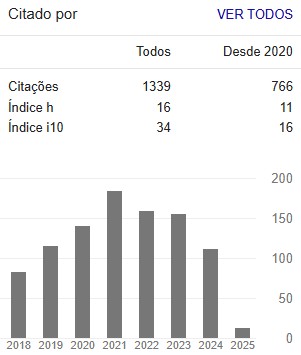DETECTION OF RESISTANCE TO METHICILLIN AND MACROLIDE IN Staphylococcus aureus ISOLATED COATS
Abstract
Staphylococcus aureus is a pathogenic bacterium that can integrate the human microbiota and be transferred to individual safety equipment (EPI), such as the lab coat, which is commonly used by students and healthcare professionals, and is delivered to different environments. A total of 70 S. aureus of college students 'gowns and 58.5% of college students' gowns were evaluated were S. aureus resistant to methicillin (MRSA), carrying SCCmec type I (51.2%), type III (26.8%) and type IV (9.7%). The results were erythromycin resistance, 32.8% were positive for the D test. The results were statistically significant, indicating that serum levels of MRSA and S. aureus are resistant to erythromycin and 25.7% to clindamycin. to macrolides in lab coats, emphasizing the importance of adopting biosafety norms among university students.
Downloads
Downloads
Published
Issue
Section
License
Os artigos submetidos à revista Colloquium Vitae estão licenciados conforme CC BY-NC-ND. Para mais informações sobre essa forma de Licenciamento, consulte: http://creativecommons.org/licenses/by-nc-nd/4.0/.
A disponibilização é gratuita na Internet, para que os usuários possam ler, fazer download, copiar, distribuir, imprimir, pesquisar ou referenciar o texto integral dos documentos, processá-los para indexação, utilizá-los como dados de entrada de programas para softwares, ou usá-los para qualquer outro propósito legal, sem barreira financeira, legal ou técnica.

